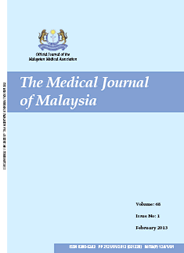MJM, Vol 70 Supplement 1 September 2015
Predictors of dengue-related mortality
in Selangor, Malaysia
*Bandar Botanic Health Clinic, Klang, Selangor, **Pandamaran Health Clinic, Klang, Selangor, ***Taman Medan Health Clinic, Petaling, Selangor, ****Vector unit, Selangor Health Department, Selangor, *****Klang Health Department, Klang, Selangor
ABSTRACT
Introduction: Dengue infection is the most common and serious arthropod borne viral disease and its clinical course can be unpredictable. The objective of this study was to determine the predictors of dengue-related mortality in a cohort of dengue patients registered in the e-dengue database in Selangor, Malaysia in 2014.
Methods: This was a retrospective cohort study on all dengue patients registered in 2014 in e-dengue database in Selangor, Malaysia. Dengue-related mortality was used as an outcome measure. Sociodemographic characteristics and clinical data were described using proportions. Associations between variables and outcome were analysed by using multivariate analysis.
Results: In 2014, a total of 54,078 dengue cases were registered into the database with 77 dengue-related mortalities, giving a dengue case fatality rate of 0.14%. The mean age of the dengue patients was 27.9 (standard deviation (SD) 15.1) years, and with more male patients (57.5%). Predictors of dengue-related mortality were older age group, i.e., 60 years and above (adjusted Odds Ratios (aOR) 5.72; 95% CI: 1.63, 20.08), female gender (aOR 2.03; 95% CI: 1.13, 3.67), Indian ethnicity (aOR 2.33; 95% CI: 1.14, 4.79) and symptoms of bleeding (aOR 10.16; 95% CI: 1.33, 77.58) at notification.
Conclusion: Dengue infection has a wide spectrum of clinical presentations and its clinical course is usually unpredictable. Hence, identification of those patients at high risk of mortality is very important to ensure appropriate monitoring, supportive treatment and referral to be delivered in the earlier stage of the disease. Predictors of dengue-related mortality were older persons, those of female gender, Indian ethnicity and those with symptoms of bleeding. These high-risk groups should be monitored closely so that early referral for hospitalisation can be made if clinically indicated.
Keywords: predictors, dengue, mortality, Selangor, Malaysia
